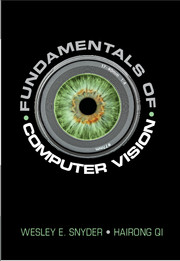Book contents
- Frontmatter
- Dedication
- Contents
- Preface
- For the Instructor
- Part I Preliminaries
- Part II Preprocessing
- 5 Kernel Operators
- 6 Noise Removal
- 7 Mathematical Morphology
- Part III Image Understanding
- Part IV The 2D Image in a 3D World
- A Support Vector Machines
- B How to Differentiate a Function Containing a Kernel Operator
- C The Image File System (IFS) Software
- Author Index
- Subject Index
- References
6 - Noise Removal
from Part II - Preprocessing
Published online by Cambridge University Press: 25 October 2017
- Frontmatter
- Dedication
- Contents
- Preface
- For the Instructor
- Part I Preliminaries
- Part II Preprocessing
- 5 Kernel Operators
- 6 Noise Removal
- 7 Mathematical Morphology
- Part III Image Understanding
- Part IV The 2D Image in a 3D World
- A Support Vector Machines
- B How to Differentiate a Function Containing a Kernel Operator
- C The Image File System (IFS) Software
- Author Index
- Subject Index
- References
Summary
To change and to change for the better are two different things.
– German proverb.Introduction
In a photosensitive device such as a phototransistor or charge-coupled device, an incidence of a photon of light may (probabilistically) generate an electronic charge. The number of charges produced should be proportional to the photons per second striking the device. However, the presence of heat (anything above absolute zero) will also randomly produce charges, and therefore signal. Such a signal is called dark current because it is a signal that is produced by a camera, even in the dark. Dark current is one of several phenomena that result in random fluctuations to the output of a camera that we call noise. The nature of noise is closely related to the type of sensor. For example, devices that count emissions of radioactive particles are corrupted by a noise that has a Poisson distribution rather than the Gaussian noise of dark current.
In this chapter, techniques are developed that remove noise and degradations so that features can be derived more cleanly for segmentation. We will introduce each topic in one dimension, to allow the student to better understand the process, and then extend that concept to two dimensions. This is covered in the following sections:
• (Section 6.2) The noise in the image can be reduced simply by smoothing. However, the smoothing process also blurs the edges. This section introduces the subject of reducing the noise while at the same time preserving edges, i.e., edge-preserving smoothing.
• (Section 6.3) An intuitive idea in designing edge-preserving smoothing is that smoothing should be associated with a weight according to the local image data where it is applied. And the weight should be large if two pixels are close spatially and have similar photometric values. Otherwise, the weight should be small. The bilateral filter is an algorithm that realizes this ad hoc “good idea.”
• (Section 6.4) Diffusion is described here to pose the denoising problem as the solution to a partial differential equation (PDE). The challenge is how to find a PDE that causes blurring except at edges.
• (Section 6.5) The Maximum A Posteriori probability (MAP) algorithm is discussed to show how to formulate noise removal as a minimization problem. Here, the challenge is to find an objective function whose minimum is the desired result.
Information
- Type
- Chapter
- Information
- Fundamentals of Computer Vision , pp. 92 - 118Publisher: Cambridge University PressPrint publication year: 2017
